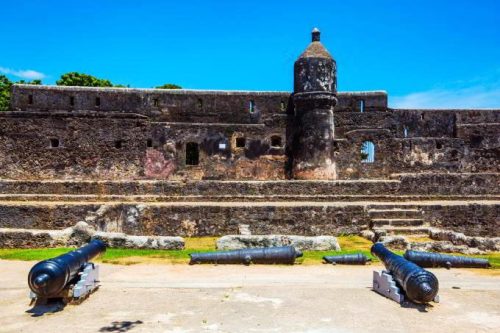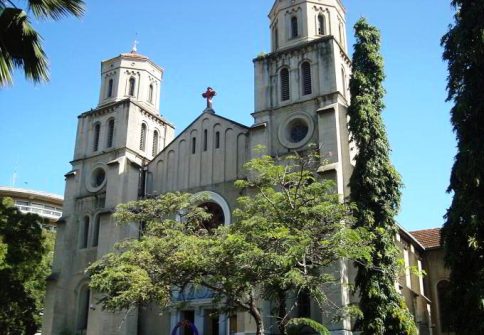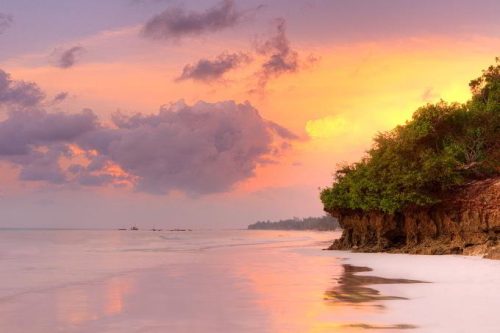Historic cities. Kenya. Mombasa. A melting pot of languages and cultures.

The city is called the “blue and white city” for the colours of its buildings which symbolize the waters of the Indian Sea that bathe it, is a coastal city with its centre on the island of the same name.
It is the second largest city in Kenya, with over one million inhabitants and a port that has connected Africa with the Middle East, China and India for many centuries. It also has a rich history. Here visitors will find traces of Persian, Arab, Portuguese, British and African culture.
Mombasa, a word of Arabic origin, was founded around 900 AD. and was initially inhabited by Swahili-speaking Bantu tribes.
By the 12th century, Mombasa had become a commercial centre
and a prosperous metropolis.
The people of Mombasa traded spices, gold and ivory as far away as China and India. Its advantageous and strategic geographical position meant that various colonial powers (Turks, Portuguese, Arabs and Persians) fought violently to conquer it.

Bastion and loopholes in the thick ancient walls. Fort Jesus. A medieval fortification in Mombasa, built in 1593. 123rf
Portugal maintained primary rule over Mombasa, albeit intermittently, from 1430 until 1730, when the Sultans of Oman established independence in 1746, strengthened by the arrival in 1840 of Said ibn Sultan. He went on to forge a large empire, controlling strategic enclaves on the African coast such as the islands of Mombasa and Zanzibar, as well as cities in India and Pakistan.
In 1887 it came under British rule and Mombasa became the capital of so-called British East Africa, a title it later retained as the capital of the Kenya Protectorate until it was replaced by Nairobi in 1905.
Today Mombasa is known as a vibrant, cosmopolitan port with a distinctive blend of African, Indian and Arab cultures, whilst embracing its ancient Swahili roots.
Each of the colonial and foreign powers left their mark, still visible today, on the city of Mombasa. Mombasa’s first buildings are found in the so-called Old Town, which has a decidedly oriental character, with wide streets and tall houses with ornate balconies. The mosques and places of worship made of stone and wood stand out. Mnara, the oldest stone mosque in the city, was built around 1300.

Holy Ghost Cathedral, Roman Catholic Archdiocese of Mombasa built in 1898. CC BY-SA 3.0/Zahra Abdulmajid
The Moroccan traveller Ibn Batuta recalls his visit to Mombasa in the early 14th century, stating that the mosques are “made of wood and built by experts “. Also noteworthy is the Mandhry Mosque, built in 1570 in the Arab-African style.
During colonization, forts were built to protect the city’s precious ports from external attacks. You can see the ruins of Fort San José, an Arab fort built in 1498 and, most importantly, Fort Jesus, built in 1593 to ensure the safety of the Portuguese living on the east coast of Africa. It is one of the oldest buildings in the city still intact and today it is a museum. Also noteworthy are the Holy Ghost Catholic Cathedral, built by missionaries in 1898, and the Hindu Shiva Temple (1952), a landmark of Hindu art and culture, with its surprising polychrome decorations. The Mombasa Tusks is one of the city’s best-known monuments, built in 1952 to commemorate Queen Elizabeth II’s visit to the city.

Today, Mombasa is a tourist destination with many beautiful white sand beaches.CC BY-SA 3.0/Łukasz Ciesielski
The Mombasa National Marine Park and Reserve (1986) for the protection of biodiversity is also worth a visit. All these buildings testify to the diversity of peoples, cultures and religions that have shaped the history of Mombasa. Mombasa is a melting pot of languages and cultures from all shores of the Indian Ocean.
Mombasa’s combination of India, Arabia and Africa has a unique charm and many visitors (Vasco de Gama did so in 1498) fall in love with East Africa’s largest and most cosmopolitan port. Today it is a tourist destination with many beautiful white sand beaches. (Building view with landmark of Mombasa. Watercolour splash with hand drawn sketch illustration in vector.123rf) – (J.J.O.)



